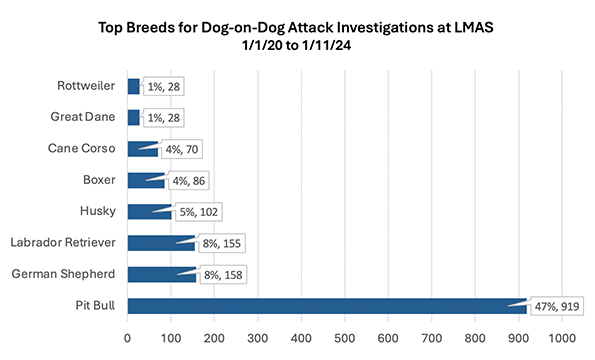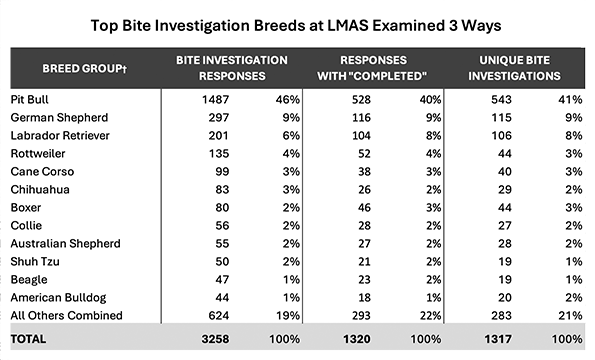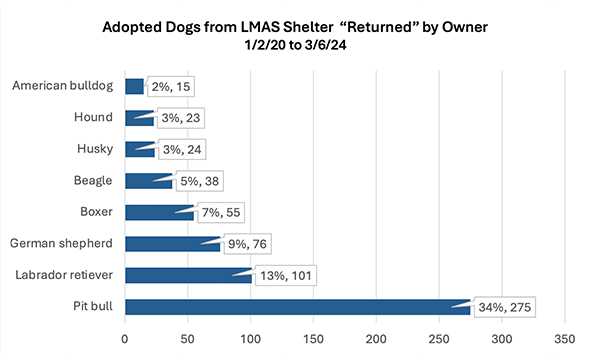
A review of Louisville Metro dog bite investigations and dog licensing data.
View All Statistics
Louisville, KY - We examined 1317 dog bite investigations by Louisville Metro Animal Services (LMAS), which required 3258 responses by animal control over a 4-year period from January 1, 2020 to January 13, 2024 to determine the top-biting breeds, sex and reproductive status. On average, each bite investigation required 2.5 responses from animal control officers. Pit bulls comprised 46% (1487) of these responses, over 5 times more than the next closest breed, German shepherds, 9% (297).
We reviewed dog license data from LMAS over the same 4-year period. Of the 52,064 dog licenses, Labrador retrievers were the most licensed breed, 10.3%, followed closely by pit bulls, 9.8%, German shepherds, 5.9%, chihuahaus, 5.3%, and beagles, 5.3%. Combined, the "unknown" and "mixed breed" groups, accounted for 6%. 200 different dog breed groups are represented in the data. There were 16 types of dog license statuses, but "current" and "renewed" statuses comprised 95% of all statuses.
We also examined various activity types by breed. Pit bulls were involved in 46% of calls for illegal dog chaining; 41% of calls requiring an animal control officer to appear in court to testify; 38% of calls involving potentially dangerous dog (PPD) papers being served; and 47% of dog-on-dog attack calls. Only pit bulls consistently had disproportionate representation in comparison to their 9.8% licensing data. Labrador retrievers had lower representation in these areas than their 10.3% licensing data.
How We Examined the Data
For over a decade our nonprofit has examined municipal dog bite statistical data. Every jurisdiction collects data differently and collects different types of data. We reviewed the Louisville open data sets for the Animal Services Activity Log, Animal Licenses, and Animal Services Intake. The activity log is a large data set that includes every call type for every animal type, including wildlife. Thus, we created formulas to capture only dog data, and within that, activity types that also captured dog breed data.
We also had to understand the abbreviations used in the activity log result columns, which are in the open data catalog. Such as COMP, completed, TTC, talk to the complainant, TTM, talk to a minor, TTO, talked to the owner, TTR, talked to the resident, UTMC, unable to make contact, UTC, unable to catch the animal, UTL, unable to locate the animal, PA, patrolled the area, NSA, no such address, GOA, gone on arrival, and many more. The activity log spreadsheet for the 4-year period is 77,705 rows of data.
| Louisville Open Data | Data Catalog | Raw Data |
|---|---|---|
| Louisville Metro, KY Animal Services Activity Log | Activity Log Catalog | DogsBite.org Raw Data |
| Louisville Metro, KY Animal License Data | Animal License Catalog | DogsBite.org Raw Data |
Dog Bite Investigations - To examine bites by breed, we analyzed the data three different ways: (1) All 3258 sequences of responses corresponding to 1317 unique bite investigations, (2) All responses when a "completed" was designated (1320), and (3) All unique bite investigations (1317). We chose the first data view, thus, some bites were counted more than once, because we wanted to review the bite investigation process and the resources required by LMAS to respond to them over the 4-year period.
Each row of data in the LMAS activity log represents a response type.
Of the 3258 bite investigation responses, 3054 (94%) had "yes" designated for a bite, 201 (6%) had "no," and 3 were blank. We included them all, as each fall within the case type, INVESTIGAT BITE, in the data set. There are 80 different activity types within the data set, including 20 different types of investigations, such as investigating animal abandonment, negligence, and abuse. We excluded all case types except for dog bites to humans, and within that, when dog breed data was known.
Dog Licensing Data - Similar to the dog bite investigation data, we created a new column, "breed group" that grouped breeds according to their primary breed plus their mix. For example, entries of "rottweiler-mix," were grouped into "rottweiler." Several breeds were grouped into a single category. For example, Alaskan husky and Siberian husky were grouped into "husky." American pit bull terrier, American Staffordshire terrier, Staffordshire bull terrier, and pit bull were grouped into "pit bull."
Of the 16 dog license statuses, "current" and "renewed" comprised 95%. Given the small percentage in the other categories there was no reason to exclude them. The data was initially sorted by animal ID and license status. We then extracted all duplicate animal IDs so that no dogs were counted more than once. We also examined each year, but the breed licensing percentages remained constant. The only category that notably shifted was "unknown," which began at 0% in 2020 and rose to 7% in 2023
Various Activity Types - When breed was known, we examined additional activity types for dogs. INVESTIGAT CHAINING, complaints of illegal dog chaining; XTRA SERVE COURT, when an animal control officer appears in court to testify or represent LMAS, and related criminal complaint duties; XTRA SERVE PDD, serving potentially dangerous dog (PPD) papers and compliance verification; and INVESTIGAT ANI ATTACK, pertaining only to dog-on-dog attacks -- all other animal types excluded.
We also reviewed activity types related to dangerous dogs, such as, ASSIST POLICE, where police requires assistance from an animal control officer; ASSIST ACO, where an animal control officer requires assistance from another AC officer, TRANSPORT HEADTOLAB, where dogs are sent to the health agency for rabies testing, often after a bite investigation; and YARD CHK, a call requiring an animal control officer to inspect a property for various reasons, such as being court ordered.
Top Dog Bite Investigation Breeds
Page 1: Top 6 Bite Investigation Breeds & Reproductive Status - Louisville, Kentucky
Despite only comprising 9.8% of dog licensing data, pit bulls accounted for 46% (1487) of the 3258 bite investigation responses by LMAS over the 4-year period. This is over 5 times higher than the next closest breed, German shepherds, which comprised 5.9% of dog licensing data and accounted for 9% (297) of bite investigation responses. Labrador retrievers comprised 10.3% of dog licensing data, the highest of all dog breeds in Louisville, and accounted for 6% (201) of bite investigation responses.
Pit bulls caused more responses than the other top-biting breeds combined (1487 v. 815) and more than 68 breeds in the "All Others" group (956).
Among the top-biting breeds, two other breeds had irregular representation. Rottweilers represent 0.9% of licensed dogs but accounted for 4% of bite investigation responses, over 4 times higher. Cane corsos represent 0.54% of licensed dogs but accounted for 3% of responses, over 5 times higher. Whereas chihuahuas represent 5.3% of licensed dogs and only accounted for 3% of responses. The non-top biting breeds, comprised of 68 breed groups, accounted for 29% (956) of responses.
Of the 3258 bite investigation responses when breed was known, sex and reproductive status was known in 95% of responses. In the LMAS open data set, male dogs are the chief biters by a 3:1 ratio, 71% male v. 23% female. All 6 top bite investigation breeds show a similar disproportion of male dogs: pit bulls, 65%, German shepherds, 78%, Labrador retrievers, 70%, rottweilers, 85%, and cane corsos, 71%. This is true in other large data sets we have reviewed (New York City and San Francisco).
Gender was known in 95% of bite investigation responses. Male dogs, 71%, were the instigators over 3 times more often than female dogs, 23%.1
Intact male dogs accounted for 44% of bite investigation responses, followed by neutered, 27%, and intact females, 15%. The sexual reproductive status is mixed amongst breeds. Intact pit bulls, German shepherds, rottweilers and cane corsos (of both sexes) instigated 62% to 83% of these responses. Intact Labrador retrievers (of both sexes) instigated 44%. Among the top bite investigation breeds, Labrador retrievers had the highest spay-neuter rate, 54%, and cane corsos had the lowest, 17%.
A Difference in Roaming?
Research has shown that neutering male dogs can reduce roaming.2 We reviewed the reproductive status of two dangerous dog activities: OWNED AGGRESSIVE, when an owned aggressive dog is at large, and STRAY AGGRS, when a stray aggressive dog is at large. When combined, intact males were higher than neutered 33% v. 26%. When only viewing the OWNED AGGRESSIVE activity, the difference is greater; 38% of owned aggressive dogs at large were intact males and 20% were neutered.

Louisville Metro dog bite investigations by breed & sex over 4-year period (2020-2023).
Louisville Metro Dog Licensing Data
Page 2: Top Licensed Dog Breeds & License Status - Louisville, Kentucky
We analyzed and compiled the dog license data to provide a baseline for this report. Over the 4-year period, LMAS data showed 52,064 dog licenses with 16 different statuses. The "current" and "renewed" statuses comprised 95% of all statuses. Labrador retrievers were the most licensed breed, 10.3% (5346), followed by pit bulls, 9.8% (5116), German shepherds, 5.9% (3081), chihuahaus, 5.3% (2753), and beagles, 5.3% (2741). Exactly 200 different dog breed groups are represented in the data.
The compliance rate for dog licenses lies between 10% to 30% in most cities. Some jurisdictions carry out a "dog census" for a more accurate dog population and breed count. Critics of using dog licensing data in statistics and comparisons say the compliance rate is too low to reach any conclusions. But understanding 30% of the dog population is better than 0%. There is no evidence that owners of different dog breeds -- beagles, boxers, or pit bulls -- treat the decision to license differently.3
The 4-year period of licensing data we reviewed, January 1, 2020 to January 13, 2024, covers the Covid years. Between 2020 and 2022 there was a 94% increase in dog licenses, according to our method of extracting duplicate records. That appears to be a Covid bump, when some people acquired a pandemic dog. LMAS offers pet licenses in 1 and 3-year increments. 3-year licenses, offered only for altered dogs, increased by 166% from 2020 to 2022, but only accounted for 17% of all licenses.
Unique bite investigations also show a Covid bump, but smaller. Between 2020 and 2022, there was a 24% increase in unique bite investigations.
Between each year, there was little variance among the top-licensed dog breeds. The only category that noticeably shifted was "unknown/unlisted," which started at 0% in 2020 and rose to 7% in 2023. To have started at 0% at the onset of the pandemic, indicates a protocol change. According to Internet Archives, Covid ceased the ability to license a dog in person at a veterinarian office in Louisville or the LMAS shelter. Thus, more people obtained a license online and apparently left the "breed field" blank.4

Louisville Metro dog licensing trends by breed over 4-year period (2020-2023).
Various Activity Types
Page 3: Top Breeds for Various Activity Types - Louisville, Kentucky
In addition to examining dog bite investigations, we reviewed other activity types by breed in the open data set. Those results predictably fell between 38% and 47% representation by pit bulls, a breed that only accounts for 9.8% of licensed dogs. Pit bulls accounted for nearly half, 46%, of illegal dog chaining investigation calls; 41% of calls requiring animal control officers to testify in court; 38% of calls involving potentially dangerous dog (PDD) papers; and 47% of dog-on-dog attack investigation calls.
Most other dog breeds represented in these activity types are proportional with their dog license population numbers, but several stand out. Dogo Argentinos represent 0.01% of licensed dogs but accounted for 10% of PDD responses. Akitas represent 0.17% of licensed dogs, but accounted for 7% of PDD responses. Of the 84 total PDD responses in the 4-year period, which involved 35 unique PDD cases, pit bulls accounted for 32, dogo Argentinos (8), akitas (6) and German shepherds (6).
On average, each PDD case required 2.4 responses by animal control officers. However, some cases involved more. The 8 responses attributed to dogo Argentinos involved a single dogo Argentino (ID A667305). Serving this dog owner PDD papers required 8 responses between 4/21/20 and 4/25/20. The most egregious case involved a single pit bull (ID A668610). Serving this dog owner PDD papers required 19 responses between 4/22/20 and 5/6/20. Both cases occurred during Covid conditions.
Dog-On-Dog Attacks
In the past, we have examined dog-on-dog attack studies from the United Kingdom (40% of attacks attributed to pit bulls), where American pit bull terriers are banned, the Netherlands (56% of attacks attributed to pit bulls), and Sweden (54% of attacks attributed to pit bulls). LMAS data shows that pit bulls accounted for 47% (919) of the dog-on-dog attack calls when breed was known (1957). This is nearly 6 times higher than the next closest breed, German shepherds, attributed to 8% (158).
We also reviewed other activity types related to dangerous dogs. Pit bulls accounted for 41% of calls where police require assistance from an animal control officer; 48% of calls where an animal control officer requires assistance from another AC officer; 64% of "transporting head" calls, where dogs are sent to the health agency for rabies testing, often after a bite investigation; and 46% of yard checks, when an animal control officer inspects a property for various reasons, such as being court ordered.

Louisville Metro dog-on-dog attack investigations by breed over 4-year period (2020-2023).
Discussion
According to LMAS dog licensing data, pit bulls are the second most popular breed, comprising 9.8% of the total licensed dogs. In the areas we examined, which pertain to dog bite investigations and dangerous dogs, pit bulls comprised 38% to 64% of activities. Pit bulls consume the lion’s share of animal control resources in these public safety areas. The most popular breed in licensing data, Labrador retrievers, comprised 10.3% of licensed dogs, but only weighed in at 0% to 9% of activities.
We analyzed the bite investigation data in three distinct ways: (1) All 3258 responses corresponding to 1317 unique bite investigations, (2) All responses when a "completed" was designated (1320), and (3) All unique bite investigations (1317). Pit bulls were responsible for 46% of bite investigation responses, 40% of responses that had a "completed" designation, and 41% of unique bite investigations. In each data view, the involvement of pit bulls was over 4 times greater than the next closest dog breed.
No matter which way you view the data, pit bulls are disproportionate public safety "resource consumers" in comparison to their licensing data.
The dogs involved in all three views of LMAS bite investigation data were largely male, ≥70%. This is true in data sets from other cities too. Families wanting to decrease the risk of biting, should consider a spayed female, which were involved in 5 times fewer bite investigation responses than intact males, and 3 times fewer than neutered. The reproductive status among the top bite investigation breeds was mixed. Cane corsos had the highest percentage of intact biters, Labrador retrievers had the lowest.
Both dog licensing and unique bite investigation data show a Covid bump between 2020 and 2022, 94% and 24%, respectively. Unique bite investigations fell 9% in 2023. Animal control responses to bite investigations followed a different pattern. There was a decline in animal control responses over the 4-year period. The 2020 Covid year had the most responses. Between 2020 (913) and 2022 (848), there was a 7% reduction in responses; between 2020 and 2023 (713), there was a 22% reduction.
Of the 11 animal control activity types reviewed,5 the most reoccurring animal ID (A675632) involved 31 responses to one pit bull between 1/4/2020 and 10/18/21. Over half, (19), involved a series of bite investigation responses that began on 4/28/21 and resulted in three violations on 05/23/21. Prior to the bite investigation, the dog had been at large and aggressive 5 times, involving 11 responses, which resulted in multiple citations and impoundment. This combination did not result in a PDD order.

Louisville Metro dog bite investigations by breed examined in three ways (2020-2023).6
Historically Speaking
While researching and writing this report over multiple months, Google Alerts, which should send us "newly" published articles, instead delivered to our inbox a 2006 editorial about Louisville debating a controversial dangerous dog ordinance that contained breed-specific pit bull restrictions.7 We recall this debate, as DogsBite.org launched in October 2007. Louisville opted to strip the breed-specific language from the "embattled" ordinance, which finally passed in January and December 2007.
The ordinance created a "differential license," where owners of intact dogs paid a higher licensing fee than owners of altered dogs. Owners of unaltered dogs were also required to have an approved enclosure. LMAS also stated then, "Any unaltered dog which is not licensed or permitted as required in the ordinance, and which is impounded for any reason after the effective date of this ordinance shall not be reclaimed by an owner unless the dog is spayed or neutered by or at the direction of MAS."
Despite removing the breed-specific language due to the browbeating by the Louisville Kennel Club, the club promptly sued Louisville after Ordinance No. 290 passed due to the differential license; the definitions of a "dangerous" and "potentially dangerous" dog; the enclosure requirements for unaltered dogs, the tethering restrictions, and more. The city was sued more than once over Ordinance No. 290 too. Removing the breed-specific language from the ordinance did not guarantee "lawsuit-free."
Neither the ordinance nor litigation prevented where Louisville is today -- the lion’s share of animal control resources being consumed by pit bulls.
Today, when breed is known, an upwards of 5 times more animal control resources are consumed by pit bulls in 11 public safety activities combined than the next closest breed (4625 pit bulls v. 912 German shepherds). Even a modest reduction of the pit bull population would reduce this "load" placed on LMAS resources, but the differential and breeder licensing have not been enough. Should the cane corso population rise, born of "war dog" genetics, they will unevenly add to this "load" as well.
LMAS shelter intake and outcome data reveal even more insights. From January 1, 2020 to March 9, 2024, pit bulls comprised 27% of dogs that entered the shelter, nearly 3 times more than any other dog breed. Pit bulls comprised 41% of dogs confiscated due to a violation; 36% of dogs entering the shelter dead, needing to be properly disposed of; 30% of dogs surrendered by owners; and 34% of dogs returned after being adopted by LMAS. Yet another "load" placed on LMAS resources.
City Officials had Foresight
While some cities were passing breed-specific laws in the early 2000s, Louisville adopted Ordinance No. 290, which was progressive in the South in that era, containing differential licensing, kennel licensing, tethering and more. City officials had foresight. They knew that breeding restrictions lay at the heart of the proliferation of unchecked breeding by unchecked breeders. Anti-chaining restrictions added then also stopped owners from keeping a "yard" of chained pit bulls or any chained pit bulls.
Even with their foresight, they likely slowed, but could not halt the proliferation of non-compliant pit bull breeding. This is why pit bulls still arrive at the LMAS shelter at nearly 3 times the rate than any other dog breed. This occurs even though the impoundment of an unlicensed dog results in mandatory spay and neuter. What else more can a progressive city legally do? We recommend a mandatory pit bull spay and neuter law, exemptions are always made for breeders who show their dogs.
We also recommend an audit of city resources and costs required to manage their pit bull population. It should include: all activity log responses involving pit bulls; police, sheriff, and fire public safety responses to pit bull aggression; the estimated cost of pit bull bite injuries; shelter and bite quarantine kennels occupied by pit bulls; shelter insurance and security costs related to housing dangerous pit bulls; personnel costs; costs incurred to adjudicate court cases instigated by pit bulls and more.

Adopted dogs returned to Louisville Metro animal shelter over 4-year period (2020-2023).
2Effects of Castration on Problem Behaviors in Male Dogs with Reference to Age and Duration of Behavior, by Neilson JC, Eckstein RA, Hart BL, JAVMA, 211:180, 1997.
3A 2019 survey carried out by DocuPet to Pet Licensing Organizations (PLOs) across the country states the top reason animal owners do not license their pet is because they do not perceive a value in doing so and/or they lack awareness of the need to license. "80% of respondents believe that residents fail to license their pets because it feels like an unnecessary fee or tax (it doesn’t provide value). 78% due to a lack of awareness of the need to license, 48% believe it is the actual cost of the license that deters registration, and 46% believe it is due to a lack of enforcement."
4The rise of the "unknown/unlisted" breed trend continued post-Covid as well. Between 2020 and 2021 there was a 1256% increase (18 to 244). Between 2022 and 2023 there was an 224% increase (403 to 1304). Of the total 1971 dog licenses with "unknown/unlisted" breed over the 4-year period, 87% (1706), came from just three veterinary medical offices between 2021 and 2023, and most of them, 72% (1232), were issued late-Covid/post-Covid in 2023. CDC announced on May 11, 2023 the end of the Public Health Emergency declaration.
5ASSIST ACO, ASSIST POLICE, INVESTIGAT ANI ATTACK, INVESTIGAT BITE, INVESTIGAT CHAINING, OWNED AGGRESSIVE, STRAY AGGRS, TRANSPORT HEADTOLAB, XTRA SERVE COURT, XTRA SERVE PDD, YARD CHK.
6Roughly 30 unique bite investigations contained multiple dog breeds. Thus, depending upon how the data was sorted "prior to extracting only the unique investigations," the breed results slightly vary in this data view. Pit bulls had the most variance among all top-biting breeds, from 535 (40.6%) low to 550 (41.7%) high, a variance of 15. We opted for a middle of the road sort view, which was 543 (41.2%). German shepherds had variance of 8, (115 to 123), all results =9% when rounded. Labradors had a variance of 0-4 (102 to 106), all results =8% when rounded.
7Pit bulls became part of the 2006 "dangerous dog" ordinance discussion after two people in Louisville -- Hulon Barbour, 60-years old, and Kylee Johnson, 14-months old -- were killed by pit bulls 2-weeks apart in 2005. At that time, the Louisville Kennel Club claimed that pit bulls only comprised 7% of dog bites. City officials disputed that number, stating instead that pit bulls allotted for "nearly one-third of reported attacks." In 2004, just south of Louisville, a chained pet pit bull tore the scalp off 4-year old Emily Stinnett, nearly killing her. When authorities could not find the scalp, they came to the grisly conclusion that the pit bull had probably consumed it. "Since the dog was deceased, we went ahead and opened the dog up and found the missing part of the girl's scalp in the dog's stomach," LaRue County Dep. Sheriff Russell McCoy said then. Emily's attack swiftly gained national attention and set off a national anti-chaining campaign.
Related articles:
05/02/22: Pit Bulls Lead Biting Incidents Across U.S. Cities and Counties - DogsBite.org
03/11/21: Peer-Reviewed Study Examines Dog-on-Dog Attacks in the UK by Analyzing Media Articles
06/18/20: City of Aurora, Colorado Dog Bite Statistics by Breed and Intake (2017-2019)
02/23/20: City and County of Denver Dog Bite Statistics by Breed and Injury Severity (2017-2019)




